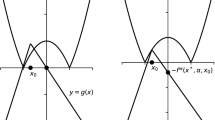Abstract
This paper develops a symmetric conjugate relation for quasi-convex functions. The concept of an evenly quasi-convex function is introduced and it is shown that this is the required property for a duality framework in quasi-convex programming.
Similar content being viewed by others
References
J.P. Crouzeix, “Contributions a l'étude des functions quasiconvex”, Thesis, Université de Clermont II (France, 1977).
J.P. Crouzeix, “A duality framework in quasi convex programming”, in: S. Schaible and W.T. Ziemba, eds.,Generalized concavity in optimization and economics (Academic Press, New York, 1981) pp. 207–225.
J.P. Crouzeix, “Continuity and differentiability properties of quasiconvex functions on ℝ”, in: S. Schaible and W.T. Ziemba, eds.,Generalized concavity in optimization and economics (Academic Press, New York, 1981) pp. 109–130.
W. Fenchel, “Convex cones, sets and functions”, Lecture Notes, Princeton University (Princeton, NJ, 1951).
W. Fenchel, “A remark on convex sets and polarity”, Communication Seminar on Mathematics, University of Lung Supplementary Volume (University of Lund, Lund, 1952) 22–89.
J. Flachs and M.A. Pollatschek, “Duality theorems for certain programs involving minimum or maximum operations,”Mathematical Programming 16 (1979) 348–370.
H.J. Greenberg and W.P. Pierskalla, “Quasi-conjugate functions and surrogate duality”,Cahiers due Center d'Etudes de Recherche Opérationnelle 15 (1973) 437–448.
V.L. Klee, “Maximal separation theorem for convex sets”,Transactions of the American Mathematical Society 134 (1968) 133–148.
J.E. Martinez Legaz, “Exact quasiconvex conjugation”, Departmento de Educaciones Functionales. Universidad de Barcelona, Spain, presented at the 11th International Symposium on Mathematical Programming (Bonn, 1982).
W. Oettli, “Optimality conditions involving generalized convex mappings”, in: S. Schaible and W.T. Ziemba, eds.,Generalized concavity in optimization and economics (Academic Press, New York, 1981) pp. 227–238.
E.Z. Prisman, “A new approach to duality Lagrangians and saddle functions in quasi convex programming”, Ph.D. Dissertation, Technion (Haifa, Israel, 1982) (in Hebrew).
R.T. Rockafellar,Convex analysis (Princeton University Press, Princeton, NJ, 1970).
I. Singer, “Pseudo-conjugate functionals and pseudo-duality”, in: Proceedings of the International Conference in Mathematical Methods in Operations Research Sofia (Publishing House of the Bulgarian Academy of Science, Sofia, 1980).
Y.I. Zabotin, A.I. Korablev and R.F. Khabibullin, “Conditions for an extremum of a functional in case of constraints”,Cybernetics 9 (1975) 982–988.
Author information
Authors and Affiliations
Rights and permissions
About this article
Cite this article
Passy, U., Prisman, E.Z. Conjugacy in quasi-convex programming. Mathematical Programming 30, 121–146 (1984). https://doi.org/10.1007/BF02591881
Received:
Revised:
Issue Date:
DOI: https://doi.org/10.1007/BF02591881




